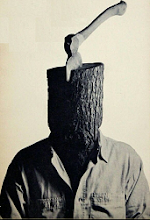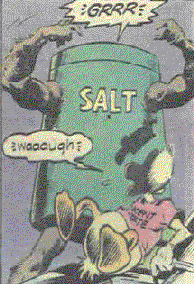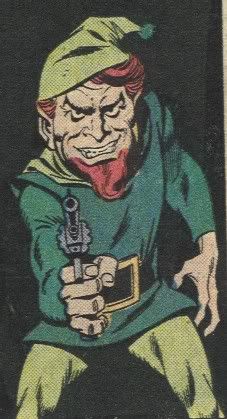Mary Sue has been bothering me lately. And I want to throw her under a bus.
You may not recognize the name, but you recognize the type. That most annoying of characters.
Who is she? She’s easy to spot. She's the idealized stand-in for the author of the story. The naked fantasy figure.
The name came from a Star Trek fan fiction story written back in yonder days. The character of “Lieutenant Mary Sue” arrives on the Starship Enterprise, and is so beautiful, brilliant, and so forth that she not only saves the day, but one (or more, I’m not sure) of the regular Trek menfolk fall madly in love with her.
Badly-written “fan fiction” is jammed with Mary Sues,
as you’d expect. What’s worse is when published fiction is marred by these authorial stand-ins. Just thinking about them makes my eyes roll back in my head.
The biggest Mary Sue producer in comicdom who leaps to mind is Matt Wagner. Take, for example, his character Grendel. Grendel was a prodigy, gifted with superhuman intelligence and physical grace. He becomes a world-class fencer in his teens, seethes with resentment at the idiots around him, is seduced by an older woman (who promptly dies), and in his late teens/early twenties, he becomes a best-selling novelist of great artistic merit in his public face as "Hunter Rose" and a masked crimelord known as "Grendel."
If this isn’t a teenage boy’s id splashed on paper, I don’t know what is. Wish fulfillment doesn’t get a lot more naked.
To his credit, Wagner took this teenage daydream character and transformed the Grendel story into something much, much more interesting. Hunter Rose died in his first story, and the subsequent
Grendel stories were about different folks. It went from a Mary Sue story to a damn fine series.
Then there’s Wagner’s
Mage. Perhaps
Mage also evolved, but I just couldn’t read it long enough to find out. I opened the first collection of the first series and couldn’t take it.
The protagonist, Kevin Matchstick, begins as a regular guy. For no readily apparent reason, in the beginning of the first issue, he sits on a stoop and begins answering personal questions to another guy sitting on the stoop. The answers are standard-issue “I’m alone and nobody gets me” horsecrap, that watered-down Byronic self-pitying wanna-be-sensitive-tough-guy knucklehead stuff common among those who consider themselves intelligent because they read the occasional book, get their feelings hurt sometimes, and wear their hair funny.
I put the book down and walked away. Hunter Rose died right away and was replaced by more nuanced characters. Kevin Matchstick is still stomping around the pages of
Mage, swinging his magic baseball bat and probably still acting the watered-down Byronic self-pitying wanna-be-sensitive-tough-guy knucklehead. No, thank you.
Wagner’s a talented creator. I actively seek out his work. But I don’t buy anything he’s done until I give it an examination first.
In the world of prose fiction, the King of Mary Sue is Elmore Leonard.
Leonard’s work has been praised so much that a few years ago, I felt I had to check it out. Most mystery and thriller writers bore me senseless. I keep hoping to find a truly good one. Thus far, the only truly good authors in the genre appear to be Hammett, Chandler, and Ross MacDonald. If Leonard’s work matched the praise, he’d fit right on that short list. Sweet.*
Oh man.
I’d never run across a middle-aged white guy Mary Sue before. Mr. Leonard introduced me to several. Chili Palmer in
Get Shorty, the title character in
Stick, um…that guy whose name I can’t remember in that book that bored me...
Leonard’s protagonists are middle-aged white guys with criminal ties who just so happen to be the most cunning, clever, lucky, and seductive middle-aged white guys around. Not that they broadcast this, oh no. The world just bows down to their inherent coolness. Manipulating the swirling madness around them with swagger, they get the best of everyone, win the (younger) girl, and make a sack of money.
Please.
I figure that the Leonard Mary Sues probably match the fantasy lives of most critics. Thus, they love it. Pandering is harder to spot when it’s in your direction.**
(Me, my fantasy life involves less gangsters and more donuts. Mmmm…donuts.)
Mary Sue-ism is a problem of degree, not type. Fictional characters are extensions of the author. Many of them are wish-fulfillment types.
What distinguishes the Mary Sue is the purity of the wish-fulfillment and the author’s over-identification with the character. She's always right, she's impossible to relate to, and you always know where a Mary Sue story is going. Yawn. Mary Sue-ism places the main character of a story in
direct violation of the First Law of Fiction: "Don't Bore the Reader."
Is Superman a Mary Sue? He’s supremely powerful and always saves the day. Not a lot of flaws in the Man of Tomorrow. Wish-fulfillment doesn’t get a lot more direct than him. So, is he?
No, because his personality is vague and bland enough to allow millions to share in the story. Nobody who wrote the character over-identified with him. One or two writers may have tried to make him their personal Mary Sue, but if so, it didn’t stick.
How about the polar opposite? The protagonist of Saul Bellow’s novel
Herzog was based on Bellow himself to such a degree that it angered a whole lot of his friends and family. Was Moses Herzog a Mary Sue?
No, because Herzog wasn’t a fantasy figure. Bellow gave the character deep flaws and provided enough distance that readers who weren’t Saul Bellow could identify with and relate to him.
...oh man. Having just put Superman and Saul Bellow side-by-side in a blog essay, I now feel dirty and wrong. I must shower now.
------------------
*I’ve tried a couple of highly-praised mystery/thriller/crime novelists and they all suck ass. George P. Pelecanos? Walter Mosely? Awful. I couldn’t finish Pelecanos’s Hell to Pay with a gun to my head, and Devil in a Blue Dress was deeply, profoundly underwhelming.
**This is why movie critics can hate Forrest Gump for pandering to normal folks, but adore Wings of Desire or Blue Velvet, movies that pander to the self-designated "arty" crowd. Folks have a much harder time noticing pandering when it’s directed at them. I certainly have that problem. Dammit.
Click here to read more!













